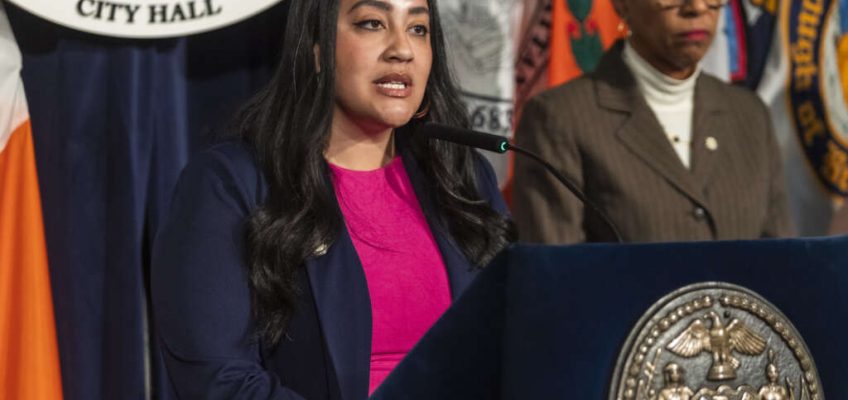“Many of the resources that our neighborhoods enjoy today—from parks to truly affordable housing and schools—were secured by the Council exercising power on behalf of residents to negotiate with the city and developers for the public good.”
Councilmember Farías, left, with Speaker Adrienne Adams at the City Council Wednesday. (Emil Cohen/NYC Council Media Unit)
One year ago, a neighborhood rezoning to promote housing development in the East Bronx surrounding newly slated Metro-North train stations yielded nearly $500 million for local parks, schools and streets. In addition to allowing the creation of an estimated 7,000 new units of housing in the Bronx, up to 500 units of homeownership were secured for our residents to access life-changing economic opportunities.
These housing and infrastructure benefits for our neighborhoods were only possible because of the community’s power to influence development through the vote of their democratically-elected representatives in the City Council.
That power is now at risk from Mayor Eric Adams’ misleading Ballot Proposals 2, 3 and 4, which would take away this voting power and give it to the mayor and their unelected appointees. These changes would eliminate the ability for neighborhoods to secure critical improvements for their parks, schools, streets and public transit, as well as housing that is affordable for local residents.
Another View: Vote Yes on Housing Ballot Proposals 2-5 (Opinion)
Fortunately in the coming election, voters throughout the city will have the opportunity to use their ballot to decide whether to keep or give away that power. Voters need to make sure they understand the proposals, because the ballot language describing them hides their real impact in an effort to mislead voters.
In the Bronx, we understand the consequences of when decisions are dictated by powerful political interests outside of our communities without any local input. Community power in the current land use process emerged as a response to racist and reckless land use policies from centrally-concentrated power that segregated neighborhoods and subjected them to higher rates of asthma and other environmental injustices.
The historic lack of investment by the city in these neighborhoods further perpetuated economic, environmental and health injustices. Many Black and Latino neighborhoods are still living with and working to undo the damage from the decades of harm this caused.
We are only now making progress from increased representation within government for communities of color, as equitable representation and power in our democracy is key to ensuring the health and well-being of every community.
Many of the resources that our neighborhoods enjoy today—from parks to truly affordable housing and schools—were secured by the Council exercising power on behalf of residents to negotiate with the city and developers for the public good.
As residents and representatives of our communities, we understand the urgency of solving our housing crisis to make life affordable for New Yorkers. Equitable and swift approval of new housing is critical to solving the housing shortage. Many Bronx communities know this well because they have contributed the most towards city housing production.
I’m proud to be a leader within this City Council that has consistently demonstrated housing leadership by approving 93 percent of housing-related land use proposals sent to us. This reveals the inaccuracy of proponents’ arguments to explain and justify these ballot proposals.
While our city must actively ensure that all areas of our city contribute their share of new housing, the answer is not to systematically disenfranchise all communities and amass power in the mayor’s office, which is what these ballot proposals do.
Mayor Adams’ ballot proposals 2, 3 and 4 make claims about affordable housing to mislead voters, but they will undermine the affordability of housing. By removing the only required vote by democratically elected representatives, they would eliminate the public’s ability to ensure that the housing built is truly affordable and development is responsive to community needs.
If enacted, Proposals 2, 3 and 4 would make it harder for everyday New Yorkers to fight for and win affordable housing and investments in parks, public transit, schools, and other essentials for our neighborhoods.
Without being pushed to do so, developers and city government have not provided housing that is affordable to residents and investments our neighborhoods need. These misleading housing ballot proposals would take away communities’ power to negotiate these essentials in development projects.
New York City belongs to its people—not to a single mayor or a handful of powerful and wealthy developers. New Yorkers should reject ballot proposals 2, 3 and 4, because they will lead to less affordable housing and more gentrification.
These proposals are designed to take away New Yorkers’ voices. We cannot let a historically unpopular mayor and powerful special interests take advantage of the public and trick us into giving away our power.
Amanda Farías is the majority leader of the New York City Council and represents Council District 18 in The Bronx.
The post Opinion: Communities’ Power in Development Decisions Helps Our Neighborhoods appeared first on City Limits.


Leave a Reply